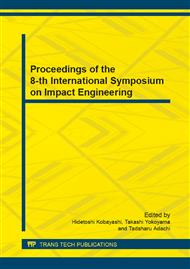p.305
p.310
p.316
p.325
p.332
p.338
p.344
p.353
p.359
Experimental and Numerical Study of a Combined Blast and Ballistic Protection
Abstract:
The work presented in this paper concerns a project on the optimization of protections subjected to explosions (IED’s threat). Explosions generate two types of threats for a protective structure: blast and impact of fragments. Perforating and non-perforating impact tests were performed in our laboratory with steel spherical projectiles impacting a target based on Kevlar® textile layers and a crushable material, Crushmat®. These tests required to develop a specific experimental test setup in order to contain the composite protective structure and to be able to measure the relevant parameters. The experiments allow us to determine the ballistic performance and basic parameters of the protection, and to validate finite element numerical models (LS-DYNA) resulting in a performant prediction tool. The approach used for the simulation consists in the representation of the full textile architecture with solid elements. Therefore, the textile material is explicitly represented in the model in order to have a good representation of the physical phenomena occurring during impact. For the crushable material, a representation using SPH was chosen in order to take the granular behaviour of this material into account. Good results are obtained with such models. However, these models are very complicated and computing time consuming. The geometry has to be well adapted and symmetry has to be exploited. On the other hand, representation of a granular material with SPH does not take into account some characteristics of this material during impact, such as the pulverisation process of the granular material. Solutions to take these phenomena into account in the model are proposed.
Info:
Periodical:
Pages:
332-337
Citation:
Online since:
June 2014
Authors:
Keywords:
Price:
Сopyright:
© 2014 Trans Tech Publications Ltd. All Rights Reserved
Share:
Citation:


